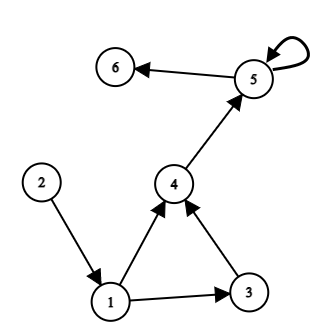Preparando MOJI
You are given a directed graph $$$G$$$ which can contain loops (edges from a vertex to itself). Multi-edges are absent in $$$G$$$ which means that for all ordered pairs $$$(u, v)$$$ exists at most one edge from $$$u$$$ to $$$v$$$. Vertices are numbered from $$$1$$$ to $$$n$$$.
A path from $$$u$$$ to $$$v$$$ is a sequence of edges such that:
We will assume that the empty sequence of edges is a path from $$$u$$$ to $$$u$$$.
For each vertex $$$v$$$ output one of four values:
Let's look at the example shown in the figure.

Then:
The first contains an integer $$$t$$$ ($$$1 \le t \le 10^4$$$) — the number of test cases in the input. Then $$$t$$$ test cases follow. Before each test case, there is an empty line.
The first line of the test case contains two integers $$$n$$$ and $$$m$$$ ($$$1 \le n \le 4 \cdot 10^5, 0 \le m \le 4 \cdot 10^5$$$) — numbers of vertices and edges in graph respectively. The next $$$m$$$ lines contain edges descriptions. Each line contains two integers $$$a_i$$$, $$$b_i$$$ ($$$1 \le a_i, b_i \le n$$$) — the start and the end of the $$$i$$$-th edge. The vertices of the graph are numbered from $$$1$$$ to $$$n$$$. The given graph can contain loops (it is possible that $$$a_i = b_i$$$), but cannot contain multi-edges (it is not possible that $$$a_i = a_j$$$ and $$$b_i = b_j$$$ for $$$i \ne j$$$).
The sum of $$$n$$$ over all test cases does not exceed $$$4 \cdot 10^5$$$. Similarly, the sum of $$$m$$$ over all test cases does not exceed $$$4 \cdot 10^5$$$.
Output $$$t$$$ lines. The $$$i$$$-th line should contain an answer for the $$$i$$$-th test case: a sequence of $$$n$$$ integers from $$$-1$$$ to $$$2$$$.
5 6 7 1 4 1 3 3 4 4 5 2 1 5 5 5 6 1 0 3 3 1 2 2 3 3 1 5 0 4 4 1 2 2 3 1 4 4 3
1 0 1 2 -1 -1 1 -1 -1 -1 1 0 0 0 0 1 1 2 1